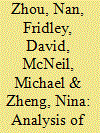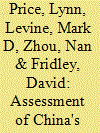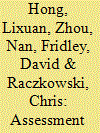|
|
|
Sort Order |
|
|
|
Items / Page
|
|
|
|
|
|
|
| Srl | Item |
| 1 |
ID:
107627


|
|
|
|
|
| Publication |
2011.
|
| Summary/Abstract |
China has implemented a series of minimum energy performance standards (MEPS) for over 30 appliances, voluntary energy efficiency label for 40 products, and a mandatory energy information label that covers 19 products to date. However, the impact of these programs and their savings potential has not been evaluated on a consistent basis. This paper uses modeling to estimate the energy saving and CO2 emission reduction potential of the appliances standard and labeling program for products for which standards are currently in place, under development or those proposed for development in 2010 under three scenarios that differ in the pace and stringency of MEPS development. In addition to a baseline "frozen efficiency" scenario at 2009 MEPS level, the "Continued Improvement Scenario" (CIS) reflects the likely pace of post-2009 MEPS revisions, and the likely improvement at each revision step. The "Best Practice Scenario" (BPS) examined the potential of an achievement of international best-practice efficiency in broad commercial use today in 2014. This paper concludes that under "CIS", cumulative electricity consumption could be reduced by 9503 TWh, and annual CO2 emissions of energy used for all 37 products would be 16% lower than in the frozen efficiency scenario. Under a "BPS" scenario for a subset of products, cumulative electricity savings would be 5450 TWh and annual CO2 emissions reduction of energy used for 11 appliances would be 35% lower.
|
|
|
|
|
|
|
|
|
|
|
|
|
|
|
|
| 2 |
ID:
103348


|
|
|
|
|
| Publication |
2011.
|
| Summary/Abstract |
From 1980 to 2002, China experienced a 5% average annual reduction in energy consumption per unit of gross domestic product (GDP). With a dramatic reversal of this historic relationship, energy intensity increased 5% per year during 2002-2005. China's 11th Five Year Plan (FYP) set a target of reducing energy intensity by 20% by 2010. This paper assesses selected policies and programs that China has instituted to fulfill the national goal, finding that China made substantial progress and many of the energy-efficiency programs appear to be on track to meet - or in some cases exceed - their energy-saving targets. Most of the Ten Key Projects, the Top-1000 Program, and the Small Plant Closure Program will meet or surpass the 11th FYP savings goals. China's appliance standards and labeling program has become very robust. China has greatly enhanced its enforcement of new building energy standards but energy-efficiency programs for buildings retrofits, as well as the goal of adjusting China's economic structure, are failing. It is important to maintain and strengthen the existing energy-saving policies and programs that are successful while revising programs or adding new policy mechanisms to improve the programs that are not on track to achieve the stated goals.
|
|
|
|
|
|
|
|
|
|
|
|
|
|
|
|
| 3 |
ID:
125868


|
|
|
|
|
| Publication |
2013.
|
| Summary/Abstract |
In recent years, China has been ambitious in investing and developing renewable energy technologies, aiming to enhance its energy security, mitigate its energy-related CO2 emissions and develop renewable energy industry. The 12th Five Year Plan (2011-2015) has set clear targets on installed capacities of different renewable energy technologies. This study aimed to assess the possible contribution of 12th Five Year Plan for China's future energy system and identify factors that might influence its impacts. First, current status of renewable energy development in China has been reviewed. Then several energy scenarios have been developed in an hourly simulation using an energy system analysis tool EnergyPLAN. It was identified that existing grid bottleneck would greatly reduce the potential contribution of renewable installations in terms of share of renewable electricity generation, share of non-fossil fuels in primary energy and system CO2 emissions. In contrast, improving technical performance of renewable energy technologies and sectoral energy efficiency plays an important role in increasing the share of renewables and promoting China's energy system transition. Finally, some policy suggestions were drawn to facilitate a better implementation of the renewable energy plan.
|
|
|
|
|
|
|
|
|
|
|
|
|
|
|
|
| 4 |
ID:
117306


|
|
|
|
|
| Publication |
2013.
|
| Summary/Abstract |
Although China became the world's largest CO2 emitter in 2007, the country has also taken serious actions to reduce its energy and carbon intensity. This study uses the bottom-up LBNL China End-Use Energy Model to assess the role of energy efficiency policies in transitioning China to a lower emission trajectory and meeting its 2020 intensity reduction goals. Two scenarios - Continued Improvement and Accelerated Improvement - were developed to assess the impact of actions already taken by the Chinese government as well as planned and potential actions, and to evaluate the potential for China to reduce energy demand and emissions. This scenario analysis presents an important modeling approach based in the diffusion of end-use technologies and physical drivers of energy demand and thereby help illuminate China's complex and dynamic drivers of energy consumption and implications of energy efficiency policies. The findings suggest that China's CO2 emissions will not likely continue growing throughout this century because of saturation effects in appliances, residential and commercial floor area, roadways, fertilizer use; and population peak around 2030 with slowing urban population growth. The scenarios also underscore the significant role that policy-driven efficiency improvements will play in meeting 2020 carbon mitigation goals along with a decarbonized power supply.
|
|
|
|
|
|
|
|
|
|
|
|
|
|
|
|
| 5 |
ID:
116740


|
|
|
|
|
| Publication |
2012.
|
| Summary/Abstract |
This study analyzes China's industrial energy consumption trends from 1996 to 2010 with a focus on the impact of the Top-1000 Enterprises Energy-Saving Program and the Ten Key Energy-Saving Projects. From 1996 to 2010, China's industrial energy consumption increased by 134%, even as the industrial economic energy intensity decreased by 46%. Decomposition analysis shows that the production effect was the dominant cause of the rapid growth in industrial energy consumption, while the efficiency effect was the major factor slowing the growth of industrial energy consumption. The structural effect had a relatively small and fluctuating influence. Analysis shows the strong association of industrial energy consumption with the growth of China's economy and changing energy policies. An assessment of the Top-1000 Enterprises Energy-Saving Program and the Ten Key Energy-Saving Projects indicates that the economic energy intensity of major energy-intensive industrial sub-sectors, as well as the physical energy intensity of major energy-intensive industrial products, decreased significantly during China's 11th Five Year Plan (FYP) period (2006-2010). This study also shows the importance and challenge of realizing structural change toward less energy-intensive activities in China during the 12th FYP period (2011-2015).
|
|
|
|
|
|
|
|
|
|
|
|
|
|
|
|
| 6 |
ID:
126545


|
|
|
|
|
| Publication |
2013.
|
| Summary/Abstract |
This paper aims to evaluate local enforcement of China's mandatory appliance and equipment energy efficiency standards and labeling programs, two increasingly important policies for meeting national energy and carbon reduction targets. The expected energy savings of efficiency standards and labels can be fully realized only with strong enforcement to ensure compliance for all products sold. This paper provides comprehensive retrospective evaluation of the methodologies, results, progress and remaining challenges in pilot enforcement projects initiated in the absence of consistent national check-testing focused on energy efficiency.
Scope
This paper's scope is focused on 2006-2009 pilot local check-tests conducted to verify appliance and equipment compliance with China's mandatory energy label and efficiency standards.
Conclusions
This paper finds both improvement and some backsliding in compliance rates over time. Compared to earlier efforts, 2009 check-tests covered a wider regional and product scope but demonstrated greater variation in compliance rates. Labeling display and energy efficiency compliance was generally high across regions and most products, but lower compliance rates were observed in less economically developed regions and for lighting and industrial products. Based on these findings, areas for improvement in local awareness, product sampling methodology, check-testing tools and procedures are identified.
|
|
|
|
|
|
|
|
|
|
|
|
|
|
|
|
| 7 |
ID:
113486


|
|
|
|
|
| Publication |
2012.
|
| Summary/Abstract |
This study analyzes current energy and carbon dioxide (CO2) emission trends in China's cement industry as the basis for modeling different levels of cement production and rates of efficiency improvement and carbon reduction in 2011-2030. Three cement output projections are developed based on analyses of historical production and physical and macroeconomic drivers. For each of these three production projections, energy savings and CO2 emission reduction potentials are estimated in a best practice scenario and two continuous improvement scenarios relative to a frozen scenario. The results reveal the potential for cumulative final energy savings of 27.1 to 37.5 exajoules and energy-related direct emission reductions of 3.2 to 4.4 gigatonnes in 2011-2030 under the best practice scenarios. The continuous improvement scenarios produce cumulative final energy savings of 6.0 to 18.9 exajoules and reduce CO2 emissions by 1.0 to 2.4 gigatonnes. This analysis highlights that increasing energy efficiency is the most important policy measure for reducing the cement industry's energy and emissions intensity, given the current state of the industry and the unlikelihood of significant carbon capture and storage before 2030. In addition, policies to reduce total cement production offer the most direct way of reducing total energy consumption and CO2 emissions.
|
|
|
|
|
|
|
|
|
|
|
|
|
|
|
|
|
|
|
|
|